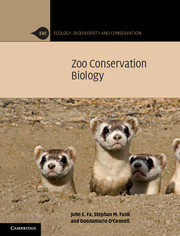Book contents
- Frontmatter
- Contents
- Foreword
- Preface
- Acknowledgements
- 1 Biodiversity and zoo conservation biology
- 2 Protecting species and habitats
- 3 Zoos in focus – public exhibition or conservation
- 4 Keeping animals in captivity
- 5 Viable captive populations – the numbers game
- 6 Captive breeding and zoos
- 7 Returning animals to the wild
- 8 Educating the public
- 9 Turning zoos into conservation centres
- Appendix 1 Commonly used abbreviations
- Appendix 2 Scientific names of species mentioned in the text
- Appendix 3 Inbreeding
- Appendix 4 Population sizes – definitions and implications
- Appendix 5 Captive breeding and genetics – definitions
- References
- Index
- Plate section
4 - Keeping animals in captivity
Published online by Cambridge University Press: 05 August 2012
- Frontmatter
- Contents
- Foreword
- Preface
- Acknowledgements
- 1 Biodiversity and zoo conservation biology
- 2 Protecting species and habitats
- 3 Zoos in focus – public exhibition or conservation
- 4 Keeping animals in captivity
- 5 Viable captive populations – the numbers game
- 6 Captive breeding and zoos
- 7 Returning animals to the wild
- 8 Educating the public
- 9 Turning zoos into conservation centres
- Appendix 1 Commonly used abbreviations
- Appendix 2 Scientific names of species mentioned in the text
- Appendix 3 Inbreeding
- Appendix 4 Population sizes – definitions and implications
- Appendix 5 Captive breeding and genetics – definitions
- References
- Index
- Plate section
Summary
‘Our animals in captivity don't fight for food. They don't have to travel long distances for food, water and shelter…They have a specially prepared diet weighed to the gram, and they have animal care staff checking them every day for injury’
(Barbara Baker)Introduction
If animals are to be kept in the best possible state for exhibition, propagation and eventual release into the wild, what are the consequences of keeping small numbers of individuals in less complex environments? Since Hediger stressed the importance of studying the reactions of animals to their confinement as early as 1934 (Meyer-Holzapfel, 1968), much research has focussed on the behaviour of vertebrates in captivity. Much is known about the conduct of captive primates and carnivores, but much less about other mammals, birds, reptiles and amphibians. The last 20 or so years have seen a substantial growth in the number of behavioural studies undertaken in zoos; some are basic research on ethology and behavioural ecology, but most are applied and designed to understand how captive environments influence behaviour (Hosey, 1997). However, interpreting the results of these studies, particularly those on the influence of the captive environment, can be difficult, because it is by no means clear what benchmark should be used for evaluating behaviours seen in captivity.
- Type
- Chapter
- Information
- Zoo Conservation Biology , pp. 84 - 111Publisher: Cambridge University PressPrint publication year: 2011



